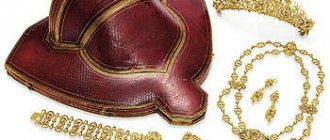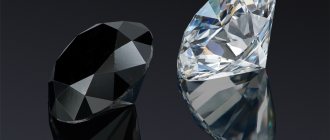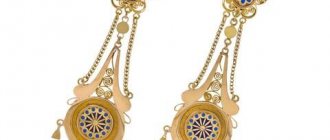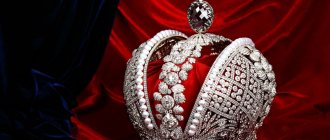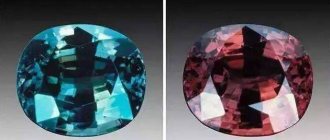Jewelry in ancient Egyptian style
They date back to ancient times. It also includes Greek and Byzantine styles. Egyptian is the most mystified. Most of the decorations contain divine images.
These are not only creatures with the bodies of people and the heads of dogs and birds, but also their earthly incarnations. The scarab, for example, is one of the forms of the god Ra. The beetle is also present in many modern Egyptian-style jewelry.
Symbolically, jewelry means a connection with the luminary, feeding it with energy. Therefore, the use of gold or alloys of yellow tones is typical for the Egyptian direction.
Silver was used less, but it was valued on a par with gold, since it was associated with Isis. This is the goddess of fertility, and at the same time the secrets of life. So, jewelry made of Egyptian style from silver appeals to the feminine, maternal, creative principles.
Since jewelry in Egypt was dedicated to deities, thus appealing to their favor, the jewelry was made massive and bright. Must be visible from heaven. By the way, the Egyptians considered each stone in jewelry to be a conductor to the energy of one of the stars.
The favorite gems of the ancient people were lapis lazuli, carnelian, rock crystal, and garnets. They are also used to decorate modern bracelets and necklaces in order to preserve the style of the Egyptian era.
Egyptian style decoration
Choosing silver - little tricks
So, having weighed all the advantages and benefits of accessories made of precious metal, you have decided to get a new ring, earrings or bracelet. Most often they are chosen based on the appearance of the product - but there are other important criteria. Here's what you need to pay attention to when purchasing:
- sample . This is a small oval or rectangular mark. It indicates the amount of pure metal in the work. Study the badge carefully - it should be deeply imprinted into the metal, have clear outlines and legible, easy to read numbers. In Ukraine, the most common standard for silver jewelry is 925 - this means that they contain 92.5% precious metal and 7.5% impurities (most often copper). This ratio ensures the shine, beauty and strength of the alloy. If the sample is lower, the accessory will darken faster due to the metal components;
- the mark is the sign of the Assay Office. This organization examines all jewelry produced by various companies and controls their purity. Each country has its own identification symbol - for example, Ukrainian works are marked with a trident, and Russian ones are marked with an image of a woman in a kokoshnik. Purchasing items without this emblem is quite risky - there is a high probability that they will be counterfeit;
- additional notes . Previously, zinc was added to the alloy used to make accessories. But further research made it possible to establish that it negatively affects the human body, often causing allergies, inflammation, and rashes. Therefore, it is better to refrain from buying things with such impurities. The absence of this substance is indicated by the stamp “Zinc free”;
- place of transaction . If you purchase silver jewelry from a licensed jewelry store, you automatically receive a guarantee of its authenticity and the possibility of compensation for damage in the event of breakage. But if you buy an accessory second-hand, you will not be able to get your money back if it turns out to be of poor quality or counterfeit. This happens especially often in resort countries - Tunisia, Turkey, Egypt. Sometimes there are really beautiful and attractive works there, but much more often tourists acquire fakes - things with a high zinc content or even made of brass, covered with a thin silver film;
- price . Although silver items cost less than gold items, too low a price should still alert you. High-quality jewelry, especially handmade, cannot be cheap.
Guided by these recommendations, you can choose high-quality, reliable and beautiful accessories that will delight you for many years!
Gothic style jewelry
Jewelry in the Gothic style is almost as massive as that of the ancient Egyptians. The philosophy of the era is based on the dream of God's city on earth. Hence the majestic structures with pointed elements.
The latter became a sign of striving for heaven. The inhabitants of the Middle Ages saw the City of God as something monumental and majestic. This was reflected in the architecture, and then in clothes and jewelry. There was no place for flying fabrics and barely visible earrings and rings.
Jewelers of the Middle Ages chose black onyx from stones. Shaded with white metals, it reminded of the frailty of existence. Rings in the shape of skulls were also associated with her. Rubies were reminiscent of the blood of God. Gothic jewelry, in general, abounds in hidden and overt symbols of faith, for example, crosses.
Oriental style jewelry
The style is timeless, connected to the geography and culture of the region. Egyptian jewelry is also oriental. The other jewels in the group are just as large. Their massiveness can be expressed in compositions of dozens of small objects.
In India, for example, they wear thin bracelets this way. But, no matter what the jewelry of the East, they are always symmetrical. Harmony is the basis of the worldview of the inhabitants of the region. They do not like disorder and believe that only symmetry can be divine.
Oriental style jewelry
Collar (30-35 cm.)
The shortest neck decoration. The English word collar means collar and it fits very tightly to the neck. They are often called a collar or collar.
ASOS DESIGN faux pearl choker
How to wear a collar
- It should be taken into account that, like any transverse line, a collar visually shortens the neck and draws increased attention to the area of the neck, chin and cheekbones.
- Looks good with off-the-shoulder evening dresses.
- Ideal for V-necks and boat necklines.
Japanese style jewelry
The Japanese focused on hair jewelry. They had not so much a religious as a social meaning. They called the similarity of hairpins, decorated with stones and flowers, kanzashi. Historically, their coloring, number and type of buds, without words, told what a woman’s origin was, what she did, whether she was married or not. Basic materials for kanzashi: wood and tortoise shell. They are also used to make other Japanese-style jewelry. Residents of the country gravitate towards natural materials with warm energy.
Cold metal is more often used for weapons than jewelry. Kanzashi style jewelry gives the warmth of natural materials. Japanese women started wearing earrings, necklaces and bracelets only a few decades ago. Before this, kimonos and hairstyles were richly decorated. There was no need for other decor. Having taken off their kimono and let their hair down, the women of the Land of the Rising Sun did not give up the abundance of silk in their jewelry. In Japanese jewelry, fabrics are equivalent to wood and bone.
Japanese style jewelry
Jewelry beauty from Byzantine times
Jewelry in the Byzantine style is often found in jewelry stores. They are exquisite and very beautiful. The main feature of the products is the presence of a large number of massive parts. They reflect all the luxury and wealth of the owner of the jewelry.
The phrase “luxury of Byzantium” is known to everyone. A large amount of gold, precious stones and openwork elements immediately pops up in the imagination. Therefore, the main features present in every Byzantine style jewelry are the following:
- the presence of one central detail - most often it is a cross made of precious metal;
- a large number of precious and semi-precious stones;
- several levels, especially in hand chains, earrings and necklaces;
- a variety of intricate and openwork designs on the rings.
Lightness, minimalism and simplicity are words that do not correspond to the Byzantine style. Jewelry made in this direction is rarely worn every day. They are more suitable for a formal appearance.
Shibori style jewelry
The cult of silk is elevated to the forefront in shibori. This is a subclass of Japanese jewelry. However, historically, shibori was invented in India, from where the technique “came” to the islands. It turns out that the style is more oriental, there is a lot of ethnicity in it.
The essence of the products is a special fabric dyeing technique. Knots are tied on them, into which the pigment only partially penetrates. As a result, stains appear on the materials. In jewelry, such fabrics are combined with beads, stones, metal pendants, and leather.
Shibori fabrics are voluminous. Without folds on fabrics, their coloring looks worse. Shibori silk ribbons are specially crimped. There is no point in crushing such beauty. Therefore, shibori style jewelry is large in size, but light, like silk itself. The basis for compositions is usually felt and leather.
The photo shows a shibori style decoration
What jewelry to choose for yourself
There are as many styles of jewelry as there are eras and cultural movements. Designers are constantly adding new details to rings, earrings and bracelets. Therefore, when choosing any jewelry, you should focus on your taste.
If you are not sure whether large and beautiful Oriental jewelry or original high-tech options are right for you, choose the classics. It has rigor, originality and versatility. Classic jewelry rings and earrings are suitable for everyday and formal wear.
Jewelry in ethno style
An even broader concept than the jewelry of the East. Ethnic jewelry includes products in national style. There may be Egyptian, Japanese, African, or Indian motifs.
Canons of beauty were created at the stage of formation of tribes. Back then they had no glass or plastic at their disposal. Ethnic style jewelry is purely natural, made from threads, feathers, shells, wood, metal and stones. Jewelers also work with leather, bones, fangs, and horsehair.
Ethnic jewelry is a material expression of the wisdom of the people and their beliefs. The Tibetans, for example, created dzi beads. These are elongated pebbles with holes in the center. Basically, they take chalcedony.
It is a type of quartz, and it is the most common mineral on earth. There is also plenty of quartz in Tibet. Images of eyes are schematically applied to dzi beads. One will give you confidence.
Two eyes promise happiness in love. Three eyes on a bead help achieve prosperity and wealth. Tibetans believe that dzi beads fell from heaven and carry their protection.
Decoration in ethno style
How is costume jewelry different from jewelry?
Costume jewelry includes all jewelry not made from gold, silver or platinum group metals. It is much more diverse than jewelry, which provides the widest field for design experiments.
Would you say that jewelry is less durable and resistant to external influences? Yes, in most cases this is true. However, if most people with an average income buy jewelry once and for the rest of their lives, then jewelry can be changed constantly. It has fallen into disrepair, is lost, is no longer liked - we replace it!
Some people say they cannot wear jewelry due to allergic reactions. Previously, nickel was used in the manufacture of inexpensive jewelry (it was even added to jewelry alloys as a brightener). Indeed, it often caused allergic reactions, so it was banned from being used for the production of jewelry.
Nowadays, costume jewelry often uses copper alloy, which is characterized by minimal risks of allergic reactions. Essentially, it is an alloy based on steel with the addition of other elements. The alloy is coated on top with a thin layer of gold (it is applied by galvanization), so that jewelry made from this material looks like gold.
Medalloy, as the name suggests, is used in medicine and cosmetology. All kinds of surgical instruments are made from it. By the way, ears are usually pierced under earrings made of copper alloy.
The list of materials that almost never cause allergic reactions does not end there. For example, titanium, which is distinguished by its champion strength, is often used in the production of men's jewelry and almost never causes allergies. Wood, bone, coral, natural latex, ceramics, leather (provided it is properly processed) and so on are also non-allergenic.
Russian style jewelry
Jewelry in the Russian style is a particular example of ethnicity. It’s easier to call them Slavic. Modern craftsmen recreate neck hryvnias. These are metal necklaces. As a rule, stylized rays extend from the base.
Reminiscent of the teeth of a crown, but they symbolize the sun. The hryvnias themselves are a barrier to the soul leaving the body. Our ancestors believed that the metal rings around the neck were a kind of lock.
Almost all Slavic jewelry had a protective meaning. In addition to metals, beads and threads were used. The Slavic style, for example, corresponds to a bauble made of red floss. This is also a ring symbol.
Color is associated with the sun, that is, light, life. But, most importantly, red is visible from afar. Evil spirits will not want to fly to the “fire”. The circle of the bracelet covers a person and does not allow evil to come to him.
In the photo there are decorations in the Slavic style
Recognizing real silver - how to recognize a fake in time
There is a steady demand for accessories made of noble metal. But, unfortunately, it is precisely because of this popularity that you can often stumble upon a cheap fake. Therefore, if you are going to buy silver jewelry, it would be useful to know how to distinguish it from imitations made from other materials. We have selected for you simple, fast, but at the same time reliable ways to determine the naturalness of a metal.
Some of these methods can be used right in the jewelry store. For example, taking the offered product in your hands, try vigorously rubbing its surface. If dark spots appear on your fingers, the alloy contains too many foreign impurities, including zinc. High-grade silver does not leave any traces or fingerprints. You can also smell the jewelry - the noble metal has a specific pleasant smell that is quite easy to detect. But fakes, as a rule, do not smell of anything.
To carry out a more detailed check, you will need some equipment. So, you can study the thermal conductivity of the metal from which the work is made. Pure silver heats up almost instantly. By immersing a product made from it in boiling water for just a moment, you will immediately feel how it warms up and then heats up.
In addition, you can check the authenticity of silver items with a magnet - the fake will be instantly attracted to it, because simple iron is often used to reduce the cost of accessories.
You also have the opportunity to test the purity of the alloy through chemical reactions. To do this, you will need to trace the accessory with a lapis pencil or a piece of ordinary school chalk. At the same time, the color of real 925 silver does not change, while its imitation made from cheaper materials will turn black (if you used lapis) or cause the chalk to darken.
Sulfur ointment has a similar effect (you can buy it at any pharmacy). Rub the jewelry with this product and leave it like that for 2-3 hours, and then wipe thoroughly. After contact with this substance, the noble metal turns black, but the fake, on the contrary, remains the same. Silver also darkens if iodine is dropped onto it and then placed in direct sunlight. However, such authentication should be resorted to only as a last resort - getting rid of the resulting stain is quite difficult.
Recently, brass products coated with a thin silver plating have been found on the shelves. They will react to the procedures described above like a real noble metal, but they can still be identified. To do this, you need to run a needle across the surface of the accessory - the sparkling film will tear, and an alloy of a different shade will be revealed underneath. True, this technique is only suitable for brass works, and besides, it irrevocably spoils the appearance of the decoration.
But still, the most reliable way to avoid stumbling upon a fake is to purchase silver products from trusted manufacturers. Thus, in his works he uses only 925 sterling metal, which is distinguished by its presentability, quality and durability.
Marine style jewelry
This style is alien to the Slavs. It is believed that the fashion of copying sailors' outfits originated in England. A portrait of the son of Louis 16 has been preserved. The child was painted by Elisabeth Vigée-Lebrun. This is a French portrait painter.
So, the heir of Louis is depicted in a suit similar to that of sailors. The people began to follow the rulers. Then, Coco Chanel introduced the nautical style to the masses. But marine-style jewelry does not end with strands of pearls, anchors and a combination of blue and white. Jewelers make shells, jellyfish, turtles, tridents and mermaids from metal and stones.
The fashion for jewelry in a nautical style arose during Art Nouveau times, that is, at the end of the 19th century. Like modern products, jewelry of the “sea” is characterized by streamlined shapes.
However, there can also be some causticism in the jewelry category. In this regard, the direction is eclectic, that is, it absorbs features of other art styles, for example, art deco. To grasp his motives, just look at the platinum star.
The metal is shaped into rough coral branches. Intertwined with oval diamonds and drop-shaped onyxes, they resemble a starfish. Pear-shaped crystals point upward with sharp edges. It seems that the decoration is prickly.
Marine style jewelry
Jewelry with features of constructivism
Constructivism (from the French constructivisme or from the Latin constructio - construction). His features:
- severity
- geometricism
- simplicity of forms and
- monolithic appearance
Revolutionary Russia gave birth to a galaxy of bright architects and constructivist artists: Ginzburg, Melnikov, Leonidov, Lisitsky, Tatlin, the Vesnin brothers.
However, constructivist jewelry is more interesting than an architectural structure. Individual parts of the jewelry “construct”, or even the entire product, can change its configuration (and sometimes its purpose). For example, these rings by Daniel Chiquet, connected to each other in a special way, form a single unit:
There are also complex products that are movably connected in several places (so-called transformers). The variability of use depends on the imagination and dexterity of the owner:
By the way, “transformers” are one of the favorite techniques of manufacturers of popular pendants for lovers today.
Here are a few more examples of products with a completely constructivist, technocratic texture:
Unlike a fixed product, a “truly constructivist” product can be sorted out and rebuilt almost overnight. Such jewelry is not at all cheap, but firstly, they are extraordinary, and secondly, they are often suitable for both men and women.
Gatsby style jewelry
"The Great Gatsby" is a novel by Francis Fitzgerald. It was published in 1925. The same year is the starting point for the Art Deco style. It replaced Art Nouveau and belongs to the latest era of art. It was the era of jazz and brilliance.
During the break between the two world wars, people tried to forget themselves, to escape from the realities of the world, surrounding themselves with luxury. Hence the deliberate decorativeness of art deco and Gatsby-style jewelry.
They have a lot of geometric patterns, color contrasts and expensive materials, for example, platinum, ivory, and diamonds. Among the favorites are also pearls. Its threads become infinitely long, sometimes hanging down to the floor, sometimes wrapping around the neck and wrists many times.
The Jazz Age is also famous for hair jewelry. The ladies began to cut them off, emphasizing the beauty of their faces with hoops made of the same pearls and gold. The compositions were complemented with feathers, opals and diamonds. These are the very jewels, looking at which you remember images of Hollywood divas, their luxurious, sophisticated and sophisticated life.
Gatsby style jewelry
Georgian period
Period: 1714-1837
Character traits:
- motifs: feathers, crowns, leaves, flowers; cornucopia, cross, bow, crescent, ribbons
- stones: garnet, topaz, emerald, ruby, turquoise, translucent agates, carnelian; coral, amber, ivory, pearl
- pinchbeck and tombac jewelry
- techniques: enameling, portrait miniatures, stamping, gimp
- to enhance the shine of diamonds, the backs of the jewelry were closed
- paste rhinestones, opal glass, artificial pearls, porcelain, beads
- 18k gold
- pear cut
Jewelry in Provence style
This style is opposed to art deco. Instead of the glitter of the big city, there is rustic comfort. Provence is a region of France where agricultural plots, vineyards, and lavender fields are concentrated.
Its purple spikelet inflorescences are the main motif in the style’s jewelry. Lavender buds are made from amethyst, charoite and other purple stones. The products emphasize the naturalness of village life, its freedom and unpretentiousness.
Instead of elaborate geometry - flowers and petals. Instead of contrasting colors, there is a play of halftones. Instead of ostentatiously luxurious materials - any kind. Even a wreath of wildflowers is a decoration in the Provence style.
The photo shows a decoration in Provence style
Boho style jewelry
The roots of the style go back to the Middle Ages, as it borrowed its name from the gypsy tribes that roamed France in the 15th and 16th centuries. Bohemiens translates to "wandering". People of art noticed the love of freedom of the gypsies, their brightness and disobedience to general canons. This attracted the creators and they began to imitate the tramps with their clothes and jewelry.
City residents mixed their style with their own. The result was something bright, original, multi-layered. So, decorations in boho style must be extravagant.
Boho style jewelry is worn en masse. There are several rings on each finger, dozens of bracelets on the hands, and fennel threads and diamond necklaces on the neck.
The combination of penny textures, materials, designs with bohemian chic is the basis of the direction. Femininity is also required. The volume of decorations and their weight are facilitated by floral motifs, flowing ribbons, and flowers. There is ethnicity, but there is no rudeness.
Boho style jewelry
What can jewelry on a person tell you?
Jewelry can tell a lot about the person who wears it, the main thing is to understand its language. This is why bracelets and chains with charms, which are miniature themed pendants, are so popular.
Many fashionistas form their own messages to others in this way, not obvious to the uninitiated, but eloquent for attentive people who know how to read jewelry with meaning.
In addition to charms, they can tell a lot about a person:
- insert stones;
- talisman jewelry;
- jewelry with zodiac signs;
- type and position of rings on fingers;
- runes, hieroglyphs, Slavic symbols and other signs depicted on jewelry.
A cat charm symbolizes independence and sexuality, a dragonfly symbolizes readiness for transformation, an infinity sign symbolizes the desire for self-improvement, and so on. Horseshoes and clover leaves are universal talismans for good luck.
